|
Tales of Faerie had a post a while ago on Beauty's request for a rose in Beauty and the Beast. The unique request differentiates Beauty from her materialistic and greedy sisters, who ask for clothes, shoes, or other expensive ornaments. Some themes emerge when you look at different tales, and they might not be the themes you expect. In most, she asks for a rose or other flower. Other objects close to nature might be a lily, a grape, or a green nut-twig. In "The Sprig of Rosemary," the heroine picks the titular sprig herself while gathering firewood. This is a simple request in contrast to her sisters' pleas for material goods. Unless she asks for it in winter. Then it's a fantastical request that should be impossible to grant. So her request is not necessarily simple, but impossible. The rose is the most common theme that I've found, but there are other versions that make this even clearer. A singing, springing lark. Maria Tatar says the rose and the lark, like the rose, is emblematic of the girl's character. The rose symbolizes her inner beauty and the lark symbolizes her energy and liveliness. A clinking, clanking lowesleaf. This is definitely a leaf; it's just the lowe part that's confusing. There is an impossibility implied, with a simple piece of plant matter clinking and clanking like a piece of metal. Lowe might mean lion, but that's a guess. Similarly, the German for dandelion is Loewenzahn. A pennyworth of “sorrow and love” in one English tale. Here she's asking for abstract concepts. A slice of roach off a green meadow, from one Portuguese tale. This one baffled me for a long time, but turns out, it's a FISH! There's a kind of fish called a roach. (Goraz is the word in the original Portuguese.) She is asking for a fish native to a green, grassy field - something that can't possibly exist.
Further Reading Text copyright © Writing in Margins, All Rights Reserved
0 Comments
Leave a Reply. |
About
Researching folktales and fairies, with a focus on common tale types. Archives
July 2024
Categories
All
|
Writing in Margins


 RSS Feed
RSS Feed
